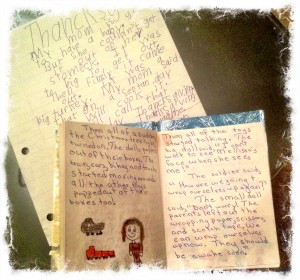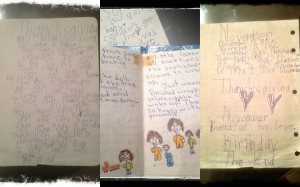Reading – Fitness for the Brain
May 22, 2013 by GradingGirl
Filed under Mini-Lessons
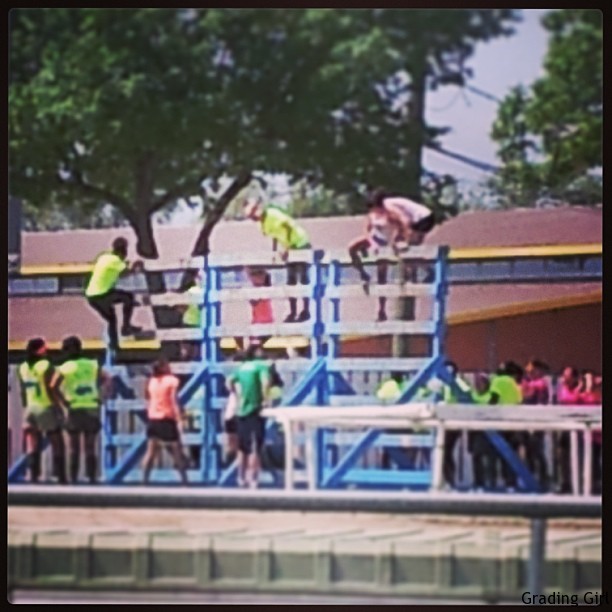
Overcome your obstacles one step at a time!
As I encourage my students to take part in our school’s summer reading program, I can’t help but remind them that their brains are muscles too that need “exercise” over the long summer break. We’re all aware of the benefits of exercise to make us stronger and healthier, and we know how much knowledge we can gain through reading. Both activities consume a significant portion of my life; it seems only fitting I provide my twist on how the two activities correlate:
1. We travel. On the track or treadmill, we walk, bike or run. When reading, we travel to destinations we may never physically reach. I’m anxious to race through And The Mountains Echoed by Khaleo Hosseini, for instance, and travel to Kabul.
2. We strive for goals. With exercise, we strive to achieve certain goals: shed pounds, prepare for a run, or master a skill. With reading, we similarly strive to achieve a goal: finish a book, read the next book in a series, or learn something found within the pages.

Maintaining balance is always key.
3. We balance. We balance what we read for fun, for work and school. Similarly, testing our balance physically benefits and lessens chance for injury.
4. We practice. In the classroom, students practice strategies modeled by the teacher until those strategies become an automatic part of one’s reading repertoire to build comprehension. In the gym, fitness folks practice exercises modeled by the personal trainer until those exercises build muscle to a desirable shape or size.
5 We hit obstacles along the way. Whether we literally hit obstacles (as pictured above) or hit a mental block and lose motivation, no one in the gym is constantly “on.” Both good and bad days play integral parts of the process to help reach goals and grow stronger. By the same token, we have good and bad times reading – sometimes there will be more distractions, some days will include more difficult text, and some days we will simply be bored. Success lies in how we face these obstacles.
6. There are no shortcuts. We can’t get stronger by osmosis; it takes some sweat but even just a few moments of exercise a day adds up to burned calories. By the same token, we can’t become better readers without reading. Study upon study shows the number one way to improve reading is simply to read – as little as 10 minutes a day is all it takes to improve our reading comprehension, fluency and enjoyment.
7. We get stronger. Day by day, rep by rep . . . our muscles grow. Lesson by lesson, book by book . . . . our brains grow smarter. 🙂
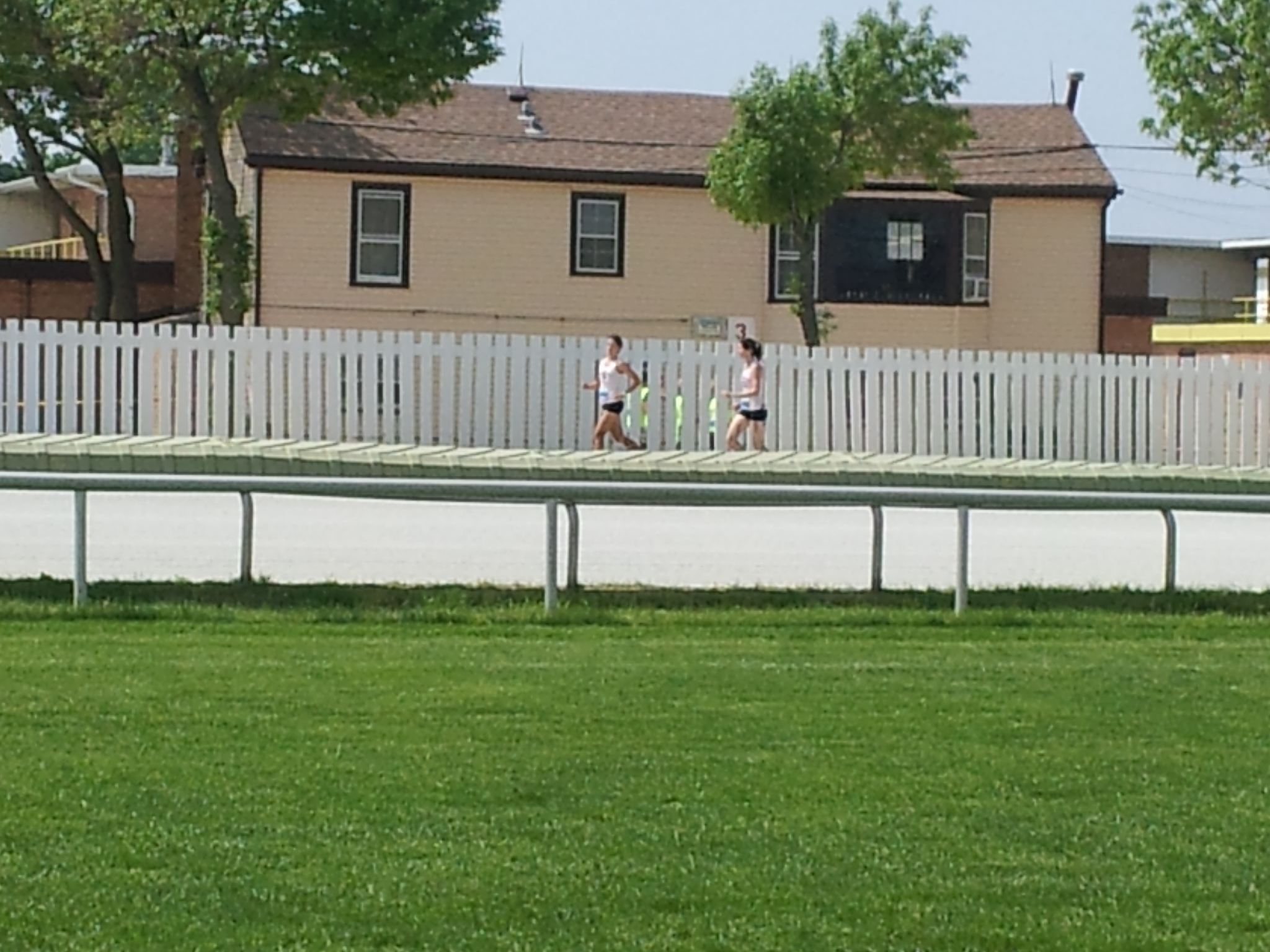
Running and Reading!
8. We get up and try again. Both are never-ending processes that cause continual growth. Whether in the gym or the classroom, we strive toward a goal, learn ways to achieve that goal, practice and encounter obstacles along the way, and keep going until we become stronger readers or fit. Keep running, keep reading!
**Thank you to Scott Robbins for these photos.**
A Turkey and Talking Toys . . . A Girl’s First Writing
January 24, 2013 by GradingGirl
Filed under Mini-Lessons, Writing Practice
I splurged on composition books for each student in my reading classes this semester; to begin, I am asking students to bring in (or snap pictures of) an early piece of writing they created when they were young. While the students will have their own web sites to post blogs, I believe good old-fashioned writing in an old-school composition book brings out authentic expression that can’t be replaced. To initiate that authenticity, I will be sharing my own writings. Here is a sampling of my first writing experiences**:
a. “Thanksgiving” – I was seven years old when I wrote this in the first grade. The only point I remember about the assignment is that we were told to write something about Thanksgiving. I associated Thanksgiving with my brother’s birthday as he was born around this feast, and I was recalling the special Thanksgiving when my mom was pregnant with my bro. To this day, I joke with him that my story about Mom having a turkey indeed came true. 🙂 This is one of my first full-length “papers.” Embarrassingly apparent is my lack of spelling skills – thank goodness I grew up relishing spelling bees and Speak & Spell (true story!).
b. “The Unusual Christmas Morning” – I sharply remember this assignment because I enjoyed it immensely – 5th grade, age 11. It involved drafting, editing, re-writing, and drawing an original Christmas story. Once the composition and drawings were complete, my teacher sent the drafts off to be “published.” I recall my anxiousness in waiting for the book to be returned all bound and neat. This particular storyline is one I was always fascinated with – toys coming to life when humans are not around – and I re-created it again and again using different settings whenever I had the urge. To this day, I am drawn to similar story lines. “King of the Dollhouse” by Patricia Clapp, “Wednesday Witch” by Ruth Chew and “The Doll People” by Brian Selznick continue claim to a closet space at this very moment. I jokingly declare that Pixar needs to send me royalties – Toy Story came after my ‘published’ piece. My mother still brings this book out to display every Christmas. Speaking of, I believe one of the reasons I’m driven with my English teaching endeavors is because reading and writing was always celebrated in my home – our fridge was consistently a landing for prized papers coupled with every room in our home accented with books thrown strategically around ( . . . . hmmm . . . sounds familiar!)
My message about writing is this: write every.single.day. Writing is a release. Writing is an expression. Writing is an extension. Writing is a connection. I learned this from these very first pieces and I continue to discover more about myself and about the writing process each day. It is a gift to take full advantage of.
When you cannot write, read. When you cannot read, write.
**This activity is an adaption from Expository Composition – Discovering Your Voice by Gary Anderson and Tony Romano (a comprehensive resource for writing I refer to again and again!)
NCTE11 News and Notes 2
December 13, 2011 by GradingGirl
Filed under Achieving Assignments, Mini-Lessons
Need some inspiration during these last few days before Winter Break?! While the following post does not give the NCTE 11 session, National Literature Project, nearly enough justice, I’m sharing a few inspirational tidbits that continue to stick with me since attending a month ago. I continue to be inspired . . . 
~ Meaning is neither in the text nor the reader. It is in the transaction.
~ Literature helps us work out our relationship with the world around us. Students have this experience all the time with games, movies, etc. We can help them see that they can get just as lost in literature!!
~ “Unless you are educated in metaphor, you are not safe to be let loose in the world.” Robert Frost
~ NAEP reading framework – % of Literature vs. Informational text: 4th grade – 50%, 8th grade – 45%, 12th grade – 30%
~ Young people betweeen the ages of 8 – 18 are using entertainment media 7 hours, 38 minutes a day!!
~ HOW they read matters much less than HOW MUCH they read!!!! (in other words, the video game magazines are helping their reading as well!!!)
~ Background knowledge only builds from reading.
~ A student, on average, takes 7 seconds to look at a painting and 36 seconds to read a plaque. In other words, students are much more likely to interpret visuals freely rather than interpret written text. Students are visual these days!!!!
~ Reading is a way to have tea with an author. 🙂
~ All teaching and learning is relational. We are creating culture and knowledge!!
______________________________________________________
Lesson idea:
A. Write a note to one your favorite authors or teachers. Include some highlights of that relationship, influences, insights gained because of the relationship, great moments, etc. Perhaps explore how you have grown with/because of this teacher or author. How has this author/teacher transformed your thinking?
B. Exchange letters with your neighbor. Cirle words that seem to capture the relationship highlighted in your neighbor’s letter.
C. Use those circled words to create a poem
D. Once poems are written, ask for volunteers to stand in a line in front of the class. One at a time, the standing students read one line from their poems. The teacher (with the help of the students) will move students around to create a “class” poem; place students in the order of lines that build upon one another.
E. Finally, read the final poem
The moral of this lesson . . . the power of attachment is so much greater than detachment.
“Produce great persons. The rest follows.” ~Walt Whitman
NCTE11 News and Notes
November 23, 2011 by GradingGirl
Filed under Achieving Assignments, Mini-Lessons
My school district afforded me the wonderful opportunity to attend my very first National Council of Teachers of English conference held in Chicago, Illinois this year. I met wonderful national colleagues, many of whom I’ve been conversing with online but never had the opportunity to meet face-to-face, and I returned to school feeling completely motivated and recharged.
The following is a sampling of tips from a session titled “Zapping Apathy: Creating a Sense of Community in English Class” Please see Gary Anderson’s informative blog, What’s Not Wrong, for more detailed information:
1. Build Community Through Movement: Chalk Talk: A silent, non-threatening way to generate ideas, spawn discussion, understand connections. Here’s my students’ first 1984 Chalk Talk. (see my sample in picture)
2. Build Community Through Online Means: 6-Word Memoirs with Wordle: A team-building, creative writing activity. First, show the following two YouTube videos – First video and Second Video. Second, students write their own six-word memoirs. Third, have students go to www.wordle.net and create and a visual of their memoirs. They’ll be able to play with font, color scheme, etc to fit their subject and make it come to life.
3. Build Community through Cell Phone Activity (shared by Lee Anne Spillane): Did you know that if students text Google, 466453, and punch in Define: (followed by the word), Google will text back a definition of that word?!
4. Build Community through Discussion – A means to get the quieter students involved. Provide envelopes filled with slips of paper numbered 1 – 10. Give these envelopes to about 4 students and have those students stand in front of class. Read a statement and ask students to hold up a slip that represents how strongly they agree with the statement.(1 = strongly disagree; 10 = strongly agree)
Like these samples? . . . see Gary Anderson’s What’s Not Wrong site for more along with the original handouts and Prezi’s from the session.
**************************************************************************************************************************
There are so many more worthwhile sessions I attended. For instance, stay tuned for a synopsis of Carol Jago’s Literature Project!!!!
Symbols, Signs and Slides
November 7, 2011 by GradingGirl
Filed under Achieving Assignments, Mini-Lessons

Whether or not you are an educator, viewing the two videos below will be worth your while. Sit back and enjoy the symbolism within our daily lives. . . .
Here is an assignment I recently shared with my two accelerated freshman English classes. We have a rigorous curriculum to follow in the classroom yet I wanted to give the students opportunity to express their more creative sides. I came up with this to supplement our study and analysis of symbolism. Aside from the period during which we watched and discussed “Words”, this is a project they had to complete solely at home on their own. The student sample below is just one example of how well they ran with this!
ASSIGNMENT:
In conjunction with our study of “The Scarlet Ibis” and symbolism, watch this video from NPR’s Radiolab to help illustrate how images are contextual. You will complete an assignment afterwards, but first I just want you to watch and enjoy it:
Now search for the word semiotics and define it. Watch the video again with that definition in mind. As you watch, write down all of the words presented through the images and sound in the video. We will discuss how the varied definitions of these words match the context within which they are shown.
For the end result, you are going to create your own video. You will need to decide on eight words of your choosing. Four of the eight words must be from our most recent vocabulary list. You must find at least two different meanings for each word and at least one image to represent each meaning.
Use PhotoPeach, MovieMaker or another program of your choice. In addition to production of your slideshow, provide a “key” that highlights which words you used along with an explanation of the word definitions. Happy producing!!!
STUDENT SAMPLE:
Click here to watch: Student Sample
STUDENT’S ANSWER KEY:
How Reading is Promoted in GG’s House
May 31, 2011 by GradingGirl
Filed under Reading Fun
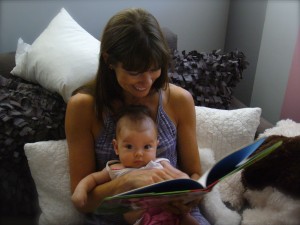
Reading with my special girl last summer!
When I was a little girl, my mother would find me with a flashlight under my bedspread reading past my bedtime. I’ve been reading since as long as I can remember – honestly, I can still visualize the pictures in my head of the first book I learned to read by myself. I’m happy to say I’ve passed this passion on to my successful, driven college-age daughter, and am now relishing the sharing sessions with my precious niece who hands me books to read again and again. As summer is upon us, there are many blogs out there divulging how to promote summer reading. I’d like to add mine to the pile with a twist of my personal methods, quirks and habits I use to promote reading in my own home:
~ Walk into my home and you won’t find a room that doesn’t have a book and/or magazine thrown or displayed in it.
~ Every holiday gift collection (Christmas, bday, Easter basket, etc) included books. Books were as exciting to receive as toys. Today, my daughter’s passion for shoes gives books a run for their money but they are still exciting nonetheless.
~ I read every day and made sure I did so in front of my daughter. I write and journal frequently, and bought her journals of her own through the years. Oh the lucky soul who finds my hidden journals someday. 😉
~ Every so often, we’d have “reading sessions.” I’d set up pillows and/or stuffed animals in a circle on the floor. I’d grab my book, my daughter would grab hers, we’d gather in the circle and read to our hearts content. We still have reading sessions on quiet summer evenings – sans the pillow circle these days – just a quiet time on the couch when we’ll both read, stop and share.
~Bi-weekly library check-out visits were treated as special events. I would never put a limit on the number of books we could bring home; we’d always walk out of there with AT LEAST ten books when my girl was little.
~ I’d peruse our local library’s event calendar and be sure to regularly take part in the storytelling sessions.
~ Speaking of the library, my daughter participated in the local library’s summer reading program every year. These programs are an absolutely fabulous way to keep kids learning as the summer rolls along.
~ I’d buy action figures or dolls of favorite characters from books to extend the story engagement.
~ Regular trips to the bookstore were also treated as special events and usually ended with scanning our new treasures over ice cream. Don’t tell my daughter I’m telling you, but she still enjoys taking a trip to our local B & N on late summer evenings with one of her good friends . . . just because. An English teacher-mom dream come true. 🙂
~ Whenever we vacationed or took long trips, we’d bring books for the rides. Reading always makes time fly. Books accompanied us to doctor and dentist visits too. This kept the ants out of our pants waiting for those delayed doctors.
~ Of course, up until she was in her upper teens we’d have, without fail, nightly story time when I would read aloud for about 10 – 20 minutes before bed. I did that literally since she was one day old and wouldn’t give up any of those moments. As both a reading teacher and a parent, I can say this may have been the most significant activity I shared with my child to promote her lifelong journey of reading, learning and discovering.
Happy Reading this summer. Above everything else, just sit back and enjoy the gifts that reading brings us!!
Involving Parents in the Classroom #1
April 24, 2011 by GradingGirl
Filed under Blogging in the Classroom, Mini-Lessons

Shakes Up Close
One of my goals as a teacher this year is to improve my communication with parents and involve them more in the classroom. Yes, I’ve been sending class newsletters, calling, emailing and meeting with parents more . . . but somehow there still seems to be a disconnect between a child’s day in high school and life at home. Here’s an idea I came up with for my honors freshmen who are in the midst of studying Shakespeare’s “Romeo & Juliet.” As I think of more parent involvement ideas, I’ll share them. Please share your ideas as well!
Instructions on our class blog:
Some teenagers don’t have any qualms over their parents approving dates, believing it is simply one more way parents show their care and concern. Other teens feel that this is not necessary and, furthermore, shows parents don’t trust a teen’s judgment. What do you feel? Should your parents approve of the people you choose to date?
Write a blog in which you respond to this persuasive prompt in the same format that you’ve been responding to with the practice prompts in class.
In your response, take a position on this question. You may write about either one of the two points of view given, or you may present a different point of view on this question. Use specific reasons and examples to support your position.
Once your response is complete, I will be inviting your parents to comment on your blogs. Regardless of their points of view, this will be a chance for your parents to share in your writing and, indirectly, share in our study of “Romeo and Juliet.” My hope is that this spurs some interesting comment feeds!
"Swear not by the moon, the inconstant moon . . ."
Parent Letter:
Dear E108 Parents,
With the celebrated observance of Shakespeare’s birthday this past weekend, it’s fitting that I’m inviting you to share in our study of “Romeo and Juliet” this week.
As you can check out on our class site, __________________ , the students are responding to the following prompt: Some teenagers don’t have any qualms over their parents approving dates, believing it is simply one more way parents show their care and concern. Other teens feel that this is not necessary and, furthermore, shows parents don’t trust a teen’s judgment. What do you feel? Should your parents approve of the people you choose to date? They are to have this complete by this Friday, April 29th.
Here’s where the fun begins! Once they complete their responses, I’m inviting you to respond to their answers. Do you agree or disagree? Why or why not? Does your child’s response surprise you? Feel free to comment in any way you wish; for instance, comments on your child’s writing are very welcome as well. My hope is that this spurs some interesting dialogue and motivates your child’s writing even further. Please respond by Friday, May 6th. I really look forward to your involvement. If you have any questions, concerns or suggestions whatsoever, please do not hesitate to contact me.
By the way, your child may come home and tell you that I brought mini-cupcakes in to celebrate the Bard’s special day. We each had a small treat today not only to celebrate our author’s day but to revel for a moment in our hard work over the past couple of weeks with practice ACT essay writing. As you know, the students have been writing numerous in-class essays addressing issues within “Romeo and Juliet” as well as persuasive prompts addressing issues pertaining to high school life. Concentrating on focus, elaboration and support is crucial to effective writing, and I’m proud that each and every student is displaying improvement. If you don’t hear from me personally via email or phone over the next week, and would like to speak about your child’s writing, please don’t hesitate to contact me.
In the meantime, as Shakespeare once wrote, “It is not in the stars to hold our destinies but in ourselves.” Have a beautiful, safe, and healthful week!
**Next newsletters – Expectations for Great Expectations, Final Exam Tips, Summer Reading and Summer Blogging suggestions
The verdict – Out of 30 students , three sets of parents did not particpate. (I had these 3 students anticipate how they believed their parents would respond and proceed from there). Some parents emailed me back stating they couldn’t wait to begin; others called eagerly with questions on specific how-tos for logging on and commenting. I may even have hooked a few on blogging themselves! Here is a sampling of student-parent interactions:
Cassidy’s Blog – Cassidy’s father took advantage of the opportunity and posted a set of suggestions to improve parent/child communication
Marley’s Blog – Both Marley’s mother and father took turns to comment.
Austin’s Blog – Austin and his father continued an engaging feed of comments.
The follow-up: Students read excerpts from The Office of Christian Parents: Shewing How Children Are To Be Gouerned throughout All Ages and Times of Their Life, all articles written in the 1600s dealing with parenting. After analyzing main parental principles, the class compared parenting today to parenting during the Elizabethan era.
What I will do differently next year: Next year I will have two sections of accelerated freshmen. I plan on getting their blogs up and running right away within the first week of school; furthermore, I plan on involving parents within the first month of class. My goal is to complete at least one parent virtual involvement per quarter. I will keep GG readers posted!
A Complimentary Lesson about Complementary Words
February 25, 2011 by GradingGirl
Filed under Grammar, Mini-Lessons
I just read an essay in which a student wrote “I gave a complement to the author after the presentation.” This prickly pair needs clarification. Here’s my complimentary mini-lesson on these two complementary words:
Complementary vs. Complimentary
Entities that go well together are complementary.
The colors blue and gray complement each other.
Two people who complete each other are considered complementary.
___________________________________
Complimentary refers to items given without charge, usually offered in addition to a product or service purchased. Additionally, it means to praise someone.
The hotel provides a complimentary breakfast to patrons who stay overnight.
The PR Vice President was very complimentary to the qualified intern candidate.
GG hopes this complimentary lessons complements your vocabulary!
All Together Now . . . Don’t Be Altogether Confused
February 4, 2011 by GradingGirl
Filed under Grammar, Mini-Lessons
This particular prickly pair of words gets my students pondering.

All Together Vs. Altogether
A. All Together means:
1. at the same time
One, two, three, all together, sing: “Sweeeeet Caroline, bum, bum, bum . . . .”
2. as a group
Let’s go to hot yoga all together: it’s much more fun that way and we can laugh as we try to hold our balance!
B. Altogether means:
1. completely
Tyler didn’t take his dog to the vet to put her to sleep until she was altogether listless and lifeless. He kept saying that she was okay, and it was very sad.
2. total
The books that shipped today were 130 copies of Great Expectations, 50 copies of “Romeo & Juliet,” and 30 copies of The Odyssey: 210 copies altogether.
3. considering everything
Altogether, it was a fabulous trip, despite the painful sun poisoning on my feet. . . .
GG mnemonic (memory trick): remember that all together – because it’s two separate words – is the one that needs to get into a group and get in sync. This associates the meaning with the spelling to help you remember which of these words is which.
Move Your Memory
January 25, 2011 by GradingGirl
Filed under Mini-Lessons
1. To memorize lists, use acronyms. For instance, to remember the names of the Great Lakes, think of HOMES: Huron, Ontario, Michigan, Erie, and Superior. NEVER EAT SOUR WATERMELON will help you remember the four directions: north, east, south, west. ROY G. BIV will help you remember the colors of the rainbow: red, orange, yellow, green, blue, indigo, and violet.
2. To memorize long numbers, divide them. Divide them into a series of smaller numbers and try to crate associations for that number. For instance, 183,332,310 becomes 18 (the “legal” age), 333 (3 three’s!), 23 (Ryne Sandberg’s #), and 10 (your curfew?).
3. To remember dates, associate them. Associate them with dates you already know. For instance, November 30th might be four days after your birthday; November 25 is Christmas Day except a month earlier. The year 1519 can be remembered as the ages of two people you know. (of course, this will only work for a year!)
More GG Memorizing Tips →
~ Rhyme it!! “Columbus sailed the ocean blue in 1492.”
~ Speak it!! To memorize my Human Anatomy notes back in college, I used to read them aloud. It worked – I earned some of the highest scores in the class (and the class was full of pre-meds!)
~ Hear it!! Record yourself reading your notes and listen to them before you go to sleep.
~ Type it!! Type all your notes on your smart phone or computer. Just typing will cause you to think about them, and you’ll remember the material longer.
~ Post it!! Put everything on Post-It notes and stick them where you’ll see them ALL the time.
You’re Wearing My Color
January 22, 2011 by GradingGirl
Filed under Mini-Lessons
It’s winter and we could all use a little more color to brighten our day . . . yes, even my West Coast friends! Just as the sun affects our moods, gazing at, wearing or surrounding ourselves with certain colors evokes different feelings. Check out my post on Colorstrology for details on the intriguing belief that we are connected to certain colors based on our birthdays.
We use color to distinguish between teams (Go Blue and Silver!), to hide pounds, to accentuate curves, to decorate rooms, to mark occasions. Just as I can’t imagine a world without music, a world without color would be a world with less smiles.
Advertisers, marketers, actors and musicians strategically use color to evoke a response from their audiences. As a semester opener for my communication classes, I ask my students to answer the following questions about colors. There are no right or wrong answers but these spawn thought and discussion as to how we can subtly use color to evoke desired responses when conveying messages. I give students slips of paper with a different color labeled on each. They answer the questions below according to their given color.
It’s your turn. Pick a color, any color, and replace the X with that color. Complete the rest of the sentence with that color in mind.
Color Questionnaire
- The personality of a person whose favorite color is X may best be described as ____________________, ____________________ and ____________________.
- The personality of a person who has an extreme dislike for X may best be described as ____________________, _________________, and _______________________.
- When I visualize X, my thoughts and feelings can best be described as: ___________________________, ______________________, and __________________________________.
- My first impression of a book whose cover is X is that the book is _________________________________.
- My first impression of a woman who wears X a great deal is that the woman is ________________________.
- My first impression of a man who wears X a great deal is that the man is ___________________________.
Color for thought:
~Do certain colors appear masculine (or communicate masculinity in some way) and certain colors appear feminine (or communicate femininity in some way)?
~Which colors would you categorize as masculine? Why?
~Which colors would you categorize as feminine? Why?
What colors would you use to communicate the following feelings and characteristics? Why?
a. Friendliness
b. Hostility
c. Warmth
d. Sex appeal
e. Love
f. Satisfaction
g. Anger
h. Strength
i. Weakness
j. Happiness
What colors would you use to package the following products? Why?
a. a new and powerful detergent
b. an expensive line of chocolate chip cookies
c. an extremely powerful personal computer
d. a mild liquid laxative
e. an expensive gold watch
GG’s reflection questions:
How universal do you think the impressions that people get from various colors are? For example, do men and women get the same impressions on the basis of color? Would young and old derive the same impressions? Would members of different cultures?
Comment your responses. This is fun!
Which Punctuation Marks You?!
October 24, 2010 by GradingGirl
Filed under Mini-Lessons, Writing Practice

You know the line from Coldplay’s “Every Teardrop is a Waterfall?” – “I’d rather be a comma than a full stop.” Which punctuation mark below would you rather be?! . . . .
. ! ? , ;
: – ( ) * #
@ / ?! & =
” { } ^ < > ‘
~ . . .
- Why did you choose the one you did? How does this represent and symbolize you?
This was one of the opening activities at an AP conference I attended. I circled the exclamation point without hesitation because I tend to overuse this mark – both in written and oral expression! In my work emails, for instance, I find myself hitting the back button to delete some to not sound overzealous. In person, I’m known to exclaim my excitement wholeheartedly and randomly. I walk into class telling my students how wonderful they are; I clap at the gym; I jump around at home. True story. As another example, my colleague claimed the % because she feels her life is divided into percentages: as teacher, mother, wife, club sponser, etc. Another example, a friend claimed he’s a semi-colon because he’s misunderstood as the semi-colon seems to be. 🙂 Which one are you?
I Am a Mini Cooper
September 24, 2010 by GradingGirl
Filed under Mini-Lessons, Writing Practice
WRITING ASSIGNMENT: Letter of Introduction
a.k.a.
Using Metaphors to Identify Ourselves
I probably should have posted this at the very beginning of the school year but it’s been a whirlwind of a year already – and we’ve only reached the very first midterm. Yippee yikes! This is the first writing assignment I gave to my accelerated freshmen this year. At the opening of the second day of class, I reveal the assignment; they have the class period in the lab to complete the letter. During Open House, I pass out the final drafts to parents.

Parents got such a kick out of this. I always try to send them home with something besides a syllabus. I received numerous emails from parents this year, in particular, stating they usually never receive anything other than a syllabus from other teachers and appreciate the bit of insight to their child’s work. Because of the great response I get, I’d thought I’d pass it on to my English/Language Arts followers. Just because their children are teenagers does not mean parents don’t need or desire detailed information about students’ lives at school. It really does not take that much more effort on our part to get that information to them; and, it feels so gratifying when we do.
Here’s the assignment. This doesn’t necessarily have to be given at the beginning of the year:
I also give my own letter as an example. Here’s an excerpt from my letter:
I am thrilled to get to know and work with each one of you this year. You don’t know too much about me yet but you soon will. To give you an idea, I am a Mini Cooper because I look small but have a powerful engine underneath. I am a wrapped present because you never know what is inside until you try to get to know me. I am a lioness because I work quietly raising my young but will roar loudly to protect. Finally, I am an unfinished novel because I have experienced many chapters in life, look forward to experiencing many more, and have yet to know the ending.
Having the students guess who wrote each letter provides additional bonus of fun. Enjoy this assignment with your students!

